Recently, one of our users asked us how they can uninstall and reinstall WordPress.
Reinstalling WordPress can solve issues when all other troubleshooting tips fail. It can be really useful if you run into an error or can’t access the WordPress admin panel.
In this article, we will show you how to safely uninstall and reinstall WordPress without losing your data or SEO rankings.
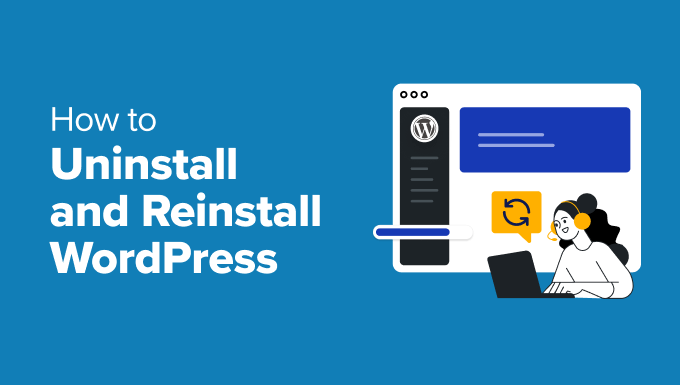
When Do You Need to Reinstall WordPress?
Reinstalling WordPress should never be the first option. Most common WordPress errors are easily fixable, and this will save you from the hassle of reinstalling WordPress.
If you cannot figure out the cause of an issue, then just follow the instructions in our WordPress troubleshooting guide. This article will help you pinpoint the issue and find a solution.
In case of a hacked WordPress site, you can try the tips in our guide on how to clean a hacked WordPress site.
Pro Tip: If you can’t restore your hacked website and need professional help, you can hire WordPress experts. WPBeginner Pro Services include hacked site repair, where our experts can get your site back up and running in no time.
If all else fails, then uninstalling and reinstalling a fresh copy of WordPress can be used as the last resort.
Step 0. Create an Emergency Backup
Before you do anything, you should first create a complete backup of your existing WordPress site.
You can use a WordPress backup plugin to do this. Make sure that you store your backup files on your computer or a cloud storage service like Google Drive or Dropbox.
We will not be using this backup to reinstall WordPress in this tutorial, but it’s good to have in case something goes wrong.
For more details, please see our beginner’s guide to backing up a WordPress site.
Step 1. Export Your WordPress Content
The first thing you need to do is export your WordPress content by creating a WordPress export file. This file will contain all your posts, pages, categories, tags, and comments.
Restoring a WordPress site using this export file allows you to leave out data created by WordPress plugins.
Here is how you will create a WordPress export file.
First, sign in to your WordPress admin area and then go to the Tools » Export page from your WordPress dashboard.
From here, select the ‘All content’ option and click on the ‘Download Export File’ button.
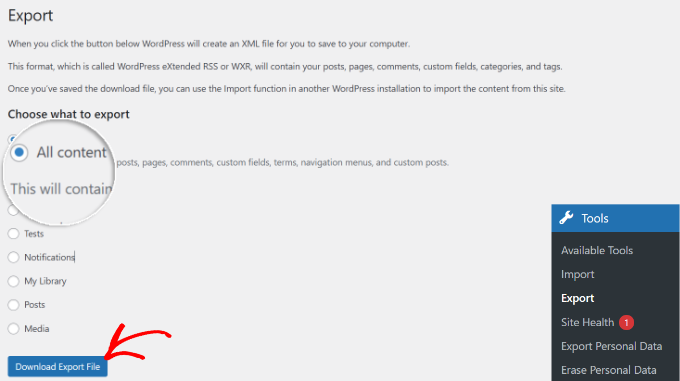
If you have a lot of registered users on your website, then you may want to export them too. See our guide on how to easily import/export users in WordPress.
Step 2. Download wp-content Folder
All your WordPress themes, plugins, images, and uploads are stored in the /wp-content/ folder on your website.
Let’s download this content to your computer so that you can use it later to reinstall WordPress.
First, you’ll need to connect to your WordPress site using an FTP client or File Manager in cPanel. Once connected, select the wp-content folder, right-click it, and click the ‘Download’ option to save it on your computer.

After downloading the wp-content folder, you are ready to uninstall WordPress.
Step 3. Properly Uninstall WordPress
To uninstall WordPress, you need to connect to your site using an FTP client or File Manager in cPanel and delete all WordPress files.
Simply select all the files and folders of your website. After that, you can right-click and select the ‘Delete’ option.
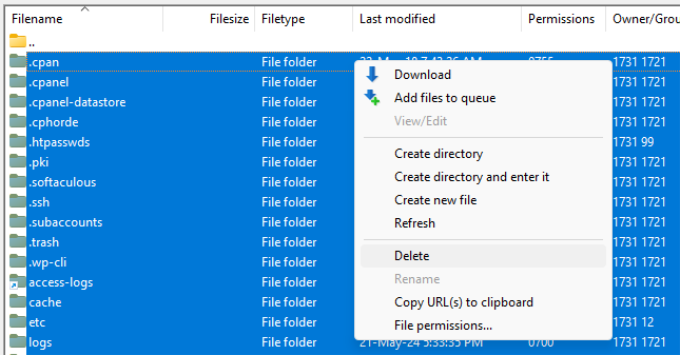
You don’t really need to delete your WordPress database. Most WordPress hosting companies allow you to create as many databases and usernames as you need.
Instead of deleting the existing database, you can create a new one with a new username and password.
To create a new database, log in to your cPanel account and click on the MySQL Databases icon.
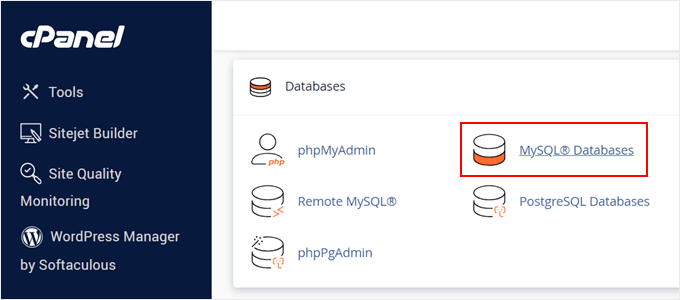
This will bring you to the add a new database page.
First, you need to enter a name for your new database and click the ‘Create Database’ button.
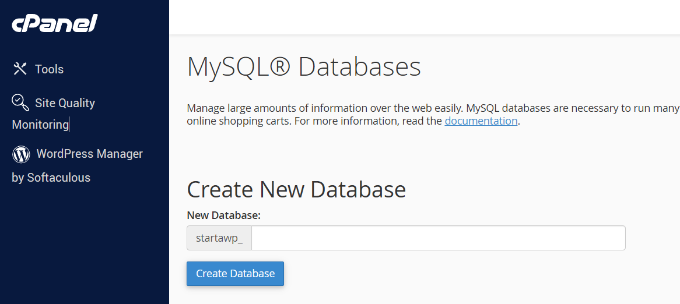
After that, scroll down to the ‘MySQL Users’ section and add a new user.
You will need to enter a username and password and then click the ‘Create User’ button. Some hosting providers also offer a password generator in cPanel.

Now, you need to add the user to the database you created earlier.
Simply scroll down to the Add User to Database section and then select the username and database you created earlier.
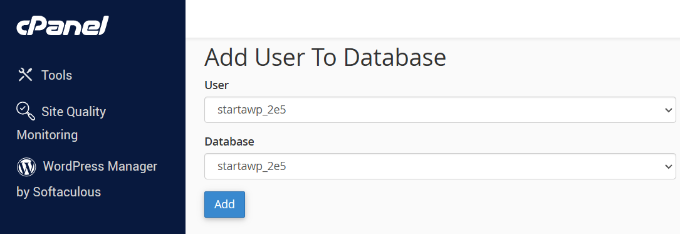
Once that’s done, click the ‘Add’ button to continue.
Your new database is ready to be used when you reinstall WordPress.
Now that you have successfully uninstalled WordPress, let’s see how to reinstall it and restore your website.
Step 4. Fresh Install WordPress
You need to download a fresh copy of WordPress from the WordPress.org website.
Simply visit the website and click the ‘Get WordPress’ button in the top right corner.

Next, you’ll see 2 options: downloading the zip file or looking for a hosting provider.
We will select the ‘Download and install it yourself’ option. Simply click the ‘Download WordPress’ button and save the zip folder on your computer.

After downloading WordPress, you need to unzip the download file.
Inside it, you will find a WordPress folder. Open the wordpress folder, and you will see all the WordPress files.
Now, you need to upload these files to your website using an FTP client. Navigate to the folder where you extracted the WordPress core files. From here, select all the files, right-click, and select the ‘Upload’ option.
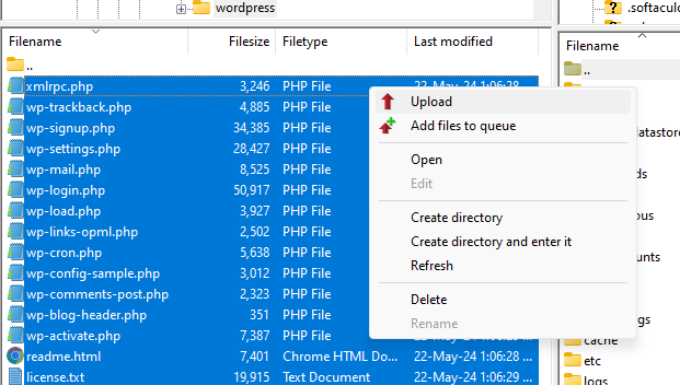
After uploading the WordPress files, go ahead and visit your website.
WordPress will now ask you to enter your database information.
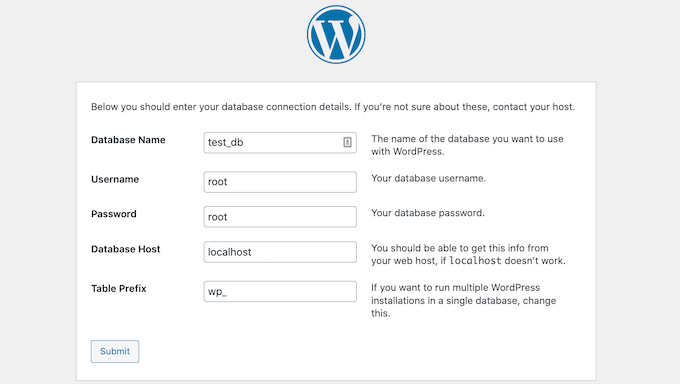
You need to enter the name of the database, username, and password you created earlier. Your host information will most likely be localhost.
Once you are done filling out the information, click on the ‘Submit’ button to continue.
WordPress will now attempt to connect to your database. Upon successful connection, it will show you a success message. You can now click on the ‘Run the installation’ button to continue.
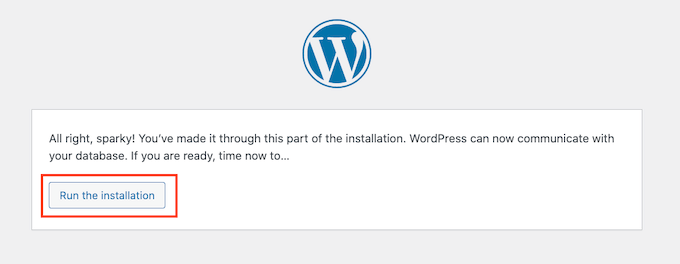
In the next step, WordPress will ask you to provide your site information, such as the site title, description, admin email address, and password.
After filling out the information, click on the ‘Install WordPress’ button to continue.
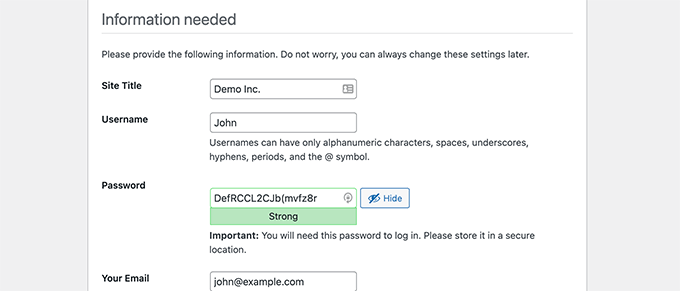
WordPress will now finish the installation. You can also see our guide on how to install WordPress.
Next, go ahead and log in to the WordPress admin area using the username and password you entered earlier.
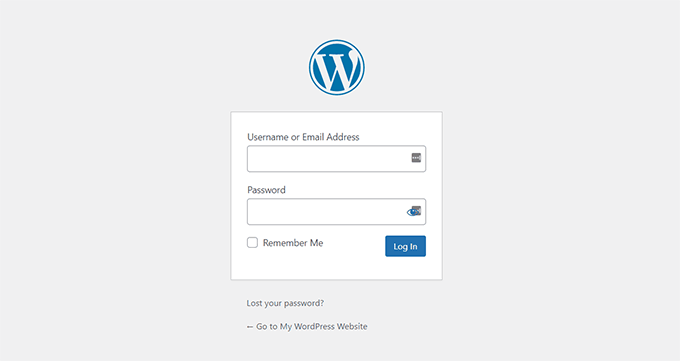
Once you are logged into WordPress, you need to delete the default content.
Simply head over to Posts and delete the ‘Hello World’ post. You can also visit the Comments section and delete the default comment. Lastly, go to Pages and delete the sample page.
You have successfully reinstalled a fresh copy of WordPress.
Now, let’s move on to restoring your content.
Step 5. Restore Uploads, Images, and Theme
First, you will need to restore your uploads, images, and theme, which are located inside the wp-content folder you downloaded earlier.
To do that, you need to connect to your website using an FTP client and go to the /wp-content/ folder.
Next, you need to select the /wp-content/uploads/ folder from your computer and upload it to your website.

If you have made changes to your WordPress theme or child theme files, then you can upload them now. Your theme folders are located in the /wp-content/themes/ folder.
Step 6. Import Content
Now, let’s import your posts, pages, categories, tags, and other content.
First, you need to go to the Tools » Import page and then click the ‘Install Now’ link under WordPress.
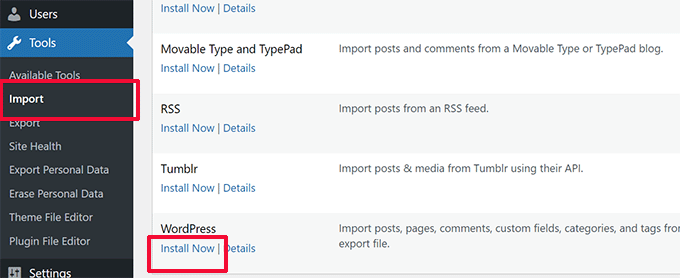
WordPress will now download and install the WordPress importer.
After that, you need to click the ‘Run Importer’ link.
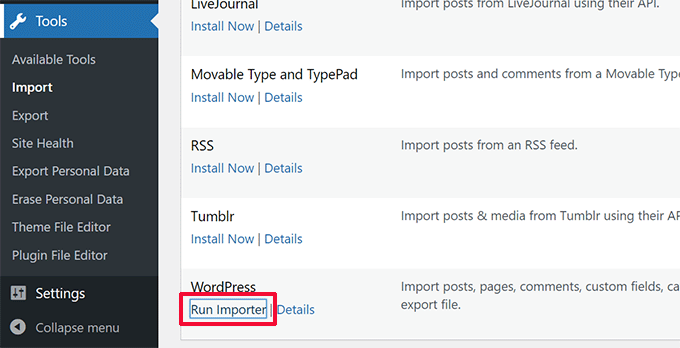
This will bring you to the WordPress importer page, where you need to click on the ‘Choose File’ button.
Then, select the XML file you downloaded during step 1.
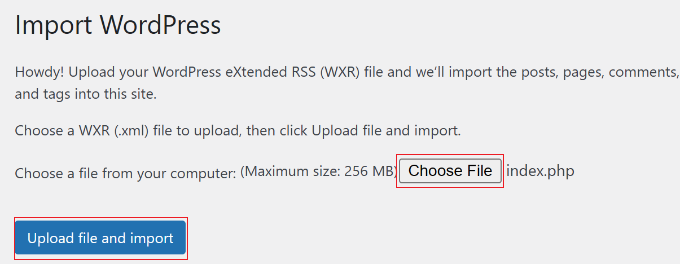
Once that’s done, click the ‘Upload file and import’ button to continue.
WordPress will ask you if you want to create new authors and assign the posts to them or if you would like to assign all posts to your current user account.
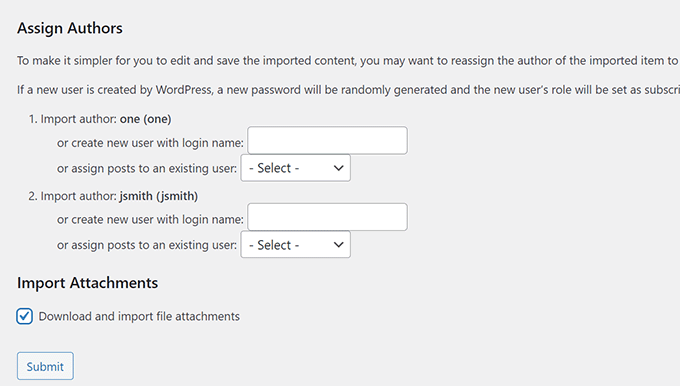
If it is a single-author WordPress site, you can assign all posts to yourself. Otherwise, do nothing, and WordPress will import the authors.
You also need to check the box under ‘Import Attachments’. This will allow WordPress to import the images from your /wp-content/uploads/ folder to the WordPress media library properly.
Go ahead and click on the ‘Submit’ button to continue.
WordPress will now start importing content from the XML file to your fresh WordPress install.
Once finished, you will be able to see your content by visiting your website.
Step 7. Install WordPress Plugins (One by One)
After successfully importing content to your reinstalled WordPress site, you can move on to installing plugins.
You will need to install all plugins one by one and then activate them. You may also need to manually set up plugins to adjust their settings.
That’s all. You have successfully uninstalled and reinstalled WordPress. You can now review your website and set up things as they were before, like your navigation menus, sidebar widgets, contact form, and more.
We hope this article helped you learn how to uninstall and reinstall WordPress. You may also want to see our complete WordPress troubleshooting guide or our expert pick of the best WordPress maintenance services.
If you liked this article, then please subscribe to our YouTube Channel for WordPress video tutorials. You can also find us on Twitter and Facebook.





Syed Balkhi says
Hey WPBeginner readers,
Did you know you can win exciting prizes by commenting on WPBeginner?
Every month, our top blog commenters will win HUGE rewards, including premium WordPress plugin licenses and cash prizes.
You can get more details about the contest from here.
Start sharing your thoughts below to stand a chance to win!
Tim Allen says
I cannot access my wp-admin dashboard to export content. But I can get into cPanel. Is there a method to uninstall/reinstall from cPanel?
WPBeginner Support says
We would first recommend going through our steps in our guide below to help you back into your admin area:
https://www.wpbeginner.com/wp-tutorials/locked-out-of-wordpress-admin/
Admin
Maarten says
“Then you need to delete all WordPress files.”,… would be handy to explain with one are WordPress files… is that everything, including htaccess?
WPBeginner Support says
It would be all of your files in the folder for your site.
Admin
Guillaume says
I just wanted to thank you for your awesome tutorial. I am interested in the Uninstall/Re-installation of WordPress. I get stuck on a 503 error as I wanted to go on my website.
WPBeginner Support says
For the 503 error, you would want to take a look at the recommendations in our article below:
https://www.wpbeginner.com/wp-tutorials/how-to-fix-503-service-unavailable-error-in-wordpress/
Admin
Vandna Namdeo says
Sir my wordpress back end Very Slow its taking too much time to do anything in admin area.
How can I fix it.
I tried all plugin uninstall and agian install but still facing same problem.
Please help me
Talha Anwar says
After doing all these steps, i have lost my featured images, none of image is being shown in media folder, but post images can be seen.
WPBeginner Support says
Hey Talha,
If you changed your WordPress theme after reinstalling WordPress theme, then you probably need to regenerate thumbnails. All your images should be stored in wp-content folder which you downloaded in Step 2.
Admin
Rabson says
hello , how can I set premium account and the customer buy it .
I want automatic process it means if customer buy premium account ,
WordPress change normal account to premium account .
tnx
WPBeginner Support says
Hey Rabson,
The best way to achieve this is by using a WordPress membership plugin.
Admin